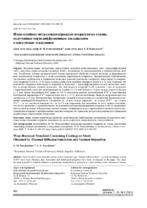| dc.contributor.author | Константинов, В. М. | |
| dc.contributor.author | Ковальчук, А. В. | |
| dc.coverage.spatial | Минск | ru |
| dc.date.accessioned | 2020-12-01T10:12:21Z | |
| dc.date.available | 2020-12-01T10:12:21Z | |
| dc.date.issued | 2020 | |
| dc.identifier.citation | Константинов, В. М. Износостойкие металлоидсодержащие покрытия на сталях, полученные термодиффузионным насыщением и вакуумным осаждением = Wear-Resistant Metalloid-Containing Coatings on Steels Obtained by Thermal Diffusion Saturation and Vacuum Deposition / В. М. Константинов, А. В. Ковальчук // Наука и техника. – 2020. – № 6. – С. 480-491. | ru |
| dc.identifier.uri | https://rep.bntu.by/handle/data/82006 | |
| dc.description.abstract | Получены новые двухслойные износостойкие покрытия композиционного типа «термодиффузионный
слой – вакуумное ионно-плазменное покрытие TiAlN», исследованы их дюрометрические и трибологические свойства. Установлено влияние предварительной химико-термической обработки стальной подложки на формирование ряда характеристик поверхности с ионно-плазменным керамическим покрытием. Предварительная карбонитрация, азотирование, карбидизация и борирование позволяют повысить фактически измеренную микротвердость поверхности с покрытием TiAlN в 3,4–13,2 раза и износостойкость по величине объемного износа в 2–3,4 раза. Отмечено, что фактически измеренная нанотвердость покрытий на подложках с термодиффузионными слоями значительно выше, чем на неупрочненных стальных подложках. Так, нанотвердость покрытий TiAlN толщиной 1 мкм на подложках с карбонитридным слоем при индентировании на глубину 0,1–0,9 мкм больше в 1,9 раза, модуль упругости больше в 1,7 раза, индекс пластичности H/E* выше на 13,0 %, показатели упругого восстановления H2/E* и сопротивления пластической деформации H3/E*2 выросли более чем в 2,1 и 2,4 раза соответственно. Вязкость разрушения при этом увеличилась в 4,5 раза. Предварительное борирование стальной подложки приводит к повышению фактически измеренной нанотвердости поверхности с покрытием до 1,8 раза, модуля упругости – до 1,8 раза, H3/E*2 – до 1,8 раза, H3/E*2 – до 1,8, жесткости поверхности – до 10,0 % при сохранении или увеличении до 8,0 % индекса пластичности H/E по сравнению с характеристиками, полученными при наноиндентировании покрытия TiAlN на неупрочненной стальной подложке. Обнаруженное явление связано с повышением вклада упрочненной подложки в упругое восстановление покрытия и индентационным откликом поверхности. Приведены результаты практического применения разработанных износостойких композиций. | ru |
| dc.language.iso | ru | ru |
| dc.publisher | БНТУ | ru |
| dc.title | Износостойкие металлоидсодержащие покрытия на сталях, полученные термодиффузионным насыщением и вакуумным осаждением | ru |
| dc.title.alternative | Wear-Resistant Metalloid-Containing Coatings on Steels Obtained by Thermal Diffusion Saturation and Vacuum Deposition | ru |
| dc.type | Article | ru |
| dc.identifier.doi | 10.21122/2227-1031-2020-19-6-480-491 | |
| local.description.annotation | New two-layer wear-resistant coatings of the composite type “thermal diffusion layer – vacuum ion-plasma coating TiAlN” have been obtained, their durometric and tribological properties have been investigated in the paper. The study has made it possible to establish influence of preliminary thermochemical treatment of a steel substrate on the formation of surface characteristics with an ion-plasma ceramic coating. Preliminary carbonitration, nitriding, carbidization and boriding permit to increase the actually measured micro-hardness of a TiAlN-coated surface by 3.4–13.2 times and wear resistance in terms of volumetric wear by 2–3.4 times. It has been noted that the actually measured nano-hardness of coatings on substrates with thermal diffusion layers is significantly higher than on unhardened steel substrates. Thus, the nano-hardness of TiAlN 1 μm-thickness coatings on substrates with a carbonitride layer when indented to a depth of 0.1–0.9 μm, is 1.9 times higher, the elastic modulus is 1.7 times higher, the ductility index H/E* is higher by 13.0 %, the rate of elastic recovery H2/E* and the rate of plastic deformation resistance H3/E*2 – have been increased by more than 2.1 and 2.4 times, respectively. The fracture toughness has been increased by 4.5 times. Preliminary boriding of the steel substrate leads to an increase in the actually measured nanohardness of the coated surface up to 1.8 times, elastic modulus up to 1.8 times, H3/E*2 – up to 1.8 times, H3/E*2 – up to 1.8 times, surface hardness – up to 10.0 %, while maintaining or increasing the plasticity index H/E up to 8.0 % in comparison with the characteristics obtained by nano-indentation of the TiAlN coating on an unhardened steel substrate. The discovered phenomenon is associated with an increase in the contribution of the hardened substrate to the elastic restoration of the coating and the indentation response of the surface. The paper presents the results of practical application of the developed wear-resistant compositions. | ru |

